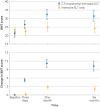Right C7 neurotomy at the intervertebral foramen plus intensive speech and language therapy versus intensive speech and language therapy alone for chronic post-stroke aphasia: multicentre, randomised controlled trial
- PMID: 40562426
- PMCID: PMC12189313
- DOI: 10.1136/bmj-2024-083605
Right C7 neurotomy at the intervertebral foramen plus intensive speech and language therapy versus intensive speech and language therapy alone for chronic post-stroke aphasia: multicentre, randomised controlled trial
Abstract
Objective: To evaluate whether right neurotomy of the seventh cervical nerve (C7) at the intervertebral foramen plus intensive speech and language therapy (SLT) improves language function compared intensive SLT alone in patients with chronic aphasia after stroke.
Design: Multicentre, assessor blinded, randomised controlled trial.
Setting: Four centres in mainland China.
Participants: 50 adults aged 40-65 years with aphasia for more than one year after a single left hemispheric stroke.
Interventions: Participants were randomised 1:1 to receive either C7 neurotomy plus three weeks of intensive SLT or three weeks of intensive SLT only, stratified by treatment centre.
Main outcome measures: The primary outcome was change in score on the 60 item Boston naming test (BNT, scores 0-60, with higher scores indicating better naming function) from baseline to one week after C7 neurotomy plus intensive SLT for three weeks or intensive SLT for three weeks after deferral for one week (control group). Secondary outcomes included change in severity of aphasia using the aphasia quotient, calculated using the western aphasia battery, and patient reported outcomes on quality of life and depression after stroke.
Results: From 25 July 2022 to 31 July 2023, 322 out of 1086 patients received a diagnosis of post-stroke aphasia and were screened for eligibility. 50 eligible participants were randomly assigned to treatment groups (25 in each). Mean increase in BNT score was 11.16 points in the neurotomy plus SLT group and 2.72 points in the control group at one month (difference 8.51 points, 95% confidence interval (CI) 5.31 to 11.71, P<0.001). The between group difference in BNT score remained stable at six months (difference 8.26 points, 4.16 to 12.35, P<0.001). In addition, the aphasia quotient improved significantly in the neurotomy plus SLT group versus control group (difference at one month 7.06 points, 4.41 to 9.72, P<0.001), as did patient reported activities of daily living and post-stroke depression. No treatment related severe adverse events were reported.
Conclusions: C7 neurotomy plus three weeks of intensive SLT was associated with a greater improvement in language function compared with three weeks of intensive SLT alone over a period of six months. No severe adverse events or long term troublesome symptoms or functional loss were reported.
Trial registration: Chinese Clinical Trial Register ChiCTR2200057180.
© Author(s) (or their employer(s)) 2019. Re-use permitted under CC BY-NC. No commercial re-use. See rights and permissions. Published by BMJ.
Conflict of interest statement
Competing interests: All authors have completed the ICMJE uniform disclosure form www.icmje.org/disclosure-of-interest/ and declare: support from the National key R&D programme of China, National Natural Science Foundation of China, Shanghai Municipal Clinical Medical Centre Project, and Shanghai Municipal Health Commission; no financial relationships with any organisations that may have a financial interest in the submitted work in the previous three years; and no relationships or activities that could have influenced the submitted work.
Figures




References
Publication types
MeSH terms
LinkOut - more resources
Full Text Sources
Medical
Miscellaneous
